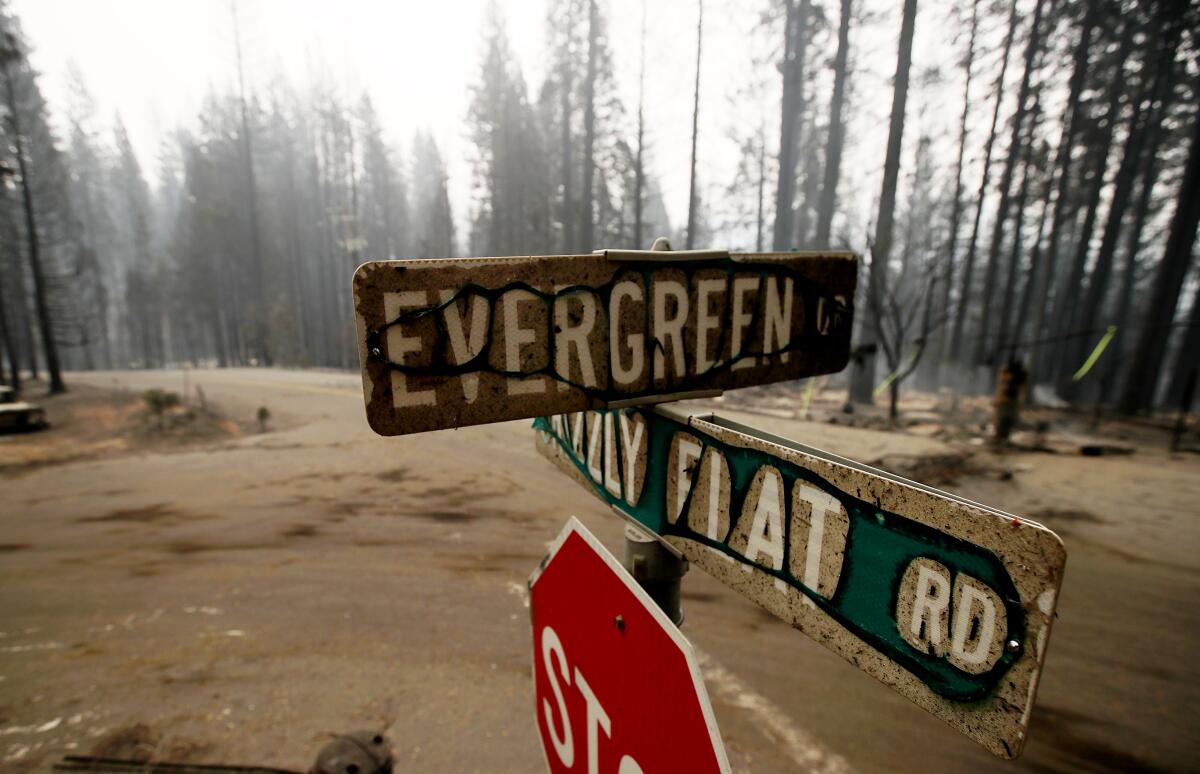Op-Ed: Disaster victims shouldn’t have to run a PR campaign to get federal aid

- Share via
Suffering is not a competition, but the battle for attention and resources tragically is.
Children killed in a school shooting, fires raging across the West, deadly tornadoes slamming the Midwest and the South — all happening against a backdrop of more than 800,000 deaths from COVID-19. After a high-profile tragedy, sustained national news coverage can bring in sympathy, charity and pressure for government aid. But what happens when the TV news crews go home? All too often, victims are left without the support they need to put their lives back together.
Tobe Magidson can attest to that. He is a homeowner in Grizzly Flats, one of the Northern California communities leveled by the Caldor fire, which burned 221,835 acres from August to October.
“We are not in this together,” he said recently. “I wake up every day looking at my ash pile. The only ones in this together with myself are my community and neighbors.”
In September, President Biden took an “aerial tour” of the area with Gov. Gavin Newsom on the eve of the recall election. In a briefing, Biden said, “We got to not just build back, we got to build back better than before.”
However, the Federal Emergency Management Agency’s declaration for El Dorado County, which includes the decimated communities of Grizzly Flats, Twin Bridges and Phillips, is not making that possible. It provided for only two types of aid: disaster response and public assistance, to cover needs such as putting out the fire, removing debris and restoring utilities. The crucial third type — individual assistance — was not made available.
The agency’s decision process is painfully opaque. Some criteria include losses by the uninsured, the population profile, impact to infrastructure, casualties and unemployment related to the disaster. But what happens if a community meets only two of the six criteria? It’s not clear.
The confusion extends across FEMA. A report released by the agency in March 2020 showed that when aid applications are rejected, sometimes no reason is given. Patterns do emerge: FEMA is less likely to give money to low-income homeowners than affluent ones, according to agency documents obtained by NPR.
Where does all that leave communities like Grizzly Flats? Unlikely to receive state aid and with little or no insurance compensation, many residents are unable to “build back better.” They’re in survival mode.
The fire, having destroyed at least 1,003 structures, left some of Magidson’s neighbors without shelter, electricity and water. Low-income residents may have no means or hope to recover. About 40% of destroyed homes were uninsured, according to George Turnboo, an El Dorado County supervisor.
This is the sort of situation that FEMA’s individual assistance is intended to address. It should be flowing to vulnerable people, including those who are disabled or elderly and on a fixed income. It should help contractors get back to work if they lost all their tools in the fire. It should give a lifeline to people who once worked in these small towns and must find new employment.
Instead, FEMA has rejected Newsom’s repeated requests for individual assistance to be made available. When such appeals have been denied, only the president can force the agency to make individual assistance available. It can happen: In 2020, the Trump administration reversed its decision to decline federal assistance for victims of wildfires across California, including the Creek fire.
Biden is likely to overrule FEMA’s decision only if he faces political pressure. But Americans who are struggling after a disaster, scrambling to find basics like shelter and water, should not have to mount a public relations campaign to get relief.
After the recent tornadoes in Kentucky, the process appears to have worked much better. FEMA immediately issued a disaster declaration making individual assistance available: funding for temporary housing, repair or replacement of owner-occupied homes, and coverage of uninsured or underinsured disaster-caused expenses.
This is what FEMA is for. All victims of natural disasters should be able to imagine building back better.
Matt Sedlar is a graduate student in sociology at George Mason University and a data analyst for the Center for Economic and Policy Research. Trisha Cumbra is a former resident of Grizzly Flats.
More to Read
A cure for the common opinion
Get thought-provoking perspectives with our weekly newsletter.
You may occasionally receive promotional content from the Los Angeles Times.










